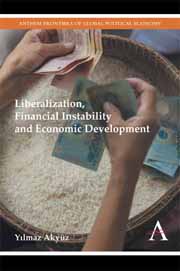Book contents
- Frontmatter
- Dedication
- Contents
- Introduction
- PART ONE LIBERALIZATION, STABILITY AND GROWTH
- PART TWO THE GLOBAL ECONOMIC CRISIS AND DEVELOPING COUNTRIES
- Chapter VI The Current Global Financial Turmoil and Asian Developing Countries
- Chapter VII The Global Economic Crisis and Asian Developing Countries: Impact, Policy Response and Medium-Term Prospects
Chapter VII - The Global Economic Crisis and Asian Developing Countries: Impact, Policy Response and Medium-Term Prospects
from PART TWO - THE GLOBAL ECONOMIC CRISIS AND DEVELOPING COUNTRIES
- Frontmatter
- Dedication
- Contents
- Introduction
- PART ONE LIBERALIZATION, STABILITY AND GROWTH
- PART TWO THE GLOBAL ECONOMIC CRISIS AND DEVELOPING COUNTRIES
- Chapter VI The Current Global Financial Turmoil and Asian Developing Countries
- Chapter VII The Global Economic Crisis and Asian Developing Countries: Impact, Policy Response and Medium-Term Prospects
Summary
Introduction
After several years of impressive growth, the world economy encountered an equally impressive downturn starting in the third quarter of 2008, triggered by financial fragility and imbalances generated by speculative lending and investment and debt-driven spending in major advanced economies (AEs), notably the United States. Initially, there was widespread optimism that growth in developing and emerging economies (DEEs) of East Asia would be decoupled from the difficulties that pervaded AEs and the region would continue to surge ahead as an autonomous growth pole. Sound balance of payments positions and self-insurance provided by large international reserves accumulated from current account surpluses and/or private capital inflows were expected to protect them against the kind of financial shocks that had devastated the region during 1997–98. In the event, however, the region could not avoid a significant drop in growth, in large part because of a sharp contraction in exports. Growth fell even in countries such as China which responded to fallouts from the crisis with massive countercyclical fiscal packages and aggressive monetary easing, while in many others growth fell to negative territory for the first time since the 1997 crisis.
Like the earlier episodes of instability, this crisis too has revealed certain structural weaknesses and vulnerabilities among various DEEs in Asia. As a result of the growth strategies pursued, economic activity has come to depend heavily on exports to major AEs or international capital flows or remittances from workers abroad and hence become highly vulnerable to their interruption.
- Type
- Chapter
- Information
- Liberalization, Financial Instability and Economic Development , pp. 259 - 292Publisher: Anthem PressPrint publication year: 2014



